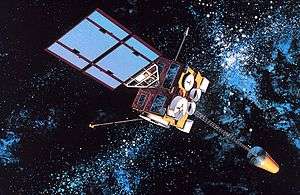GOES-T
GOES-T is the third of the 'GOES-R series', the next generation of weather satellites operated by the National Oceanic and Atmospheric Administration (NOAA), giving sequence to the GOES system. The next satellites of the series (GOES-16, GOES-17, GOES-T, and GOES-U) will extend the availability of the GOES satellite system until 2036. The satellite will be built by Lockheed Martin, it will be based on the A2100A platform and will an expected useful life of 15 years (10 operational after five years in orbit replacement).[1]
 The 'Brains' and 'Body' of the GOES-T Satellite are merged. | |
| Mission type | Earth weather forecasting |
|---|---|
| Operator | NOAA / NASA |
| Mission duration | 15 years (planned) |
| Spacecraft properties | |
| Bus | A2100 |
| Manufacturer | Lockheed Martin |
| Launch mass | 2,800 kilograms (6,200 lb) |
| Start of mission | |
| Launch date | December 2021 (planned) |
| Rocket | Atlas V |
| Launch site | Cape Canaveral Air Force Station |
| Contractor | United Launch Alliance |
| Orbital parameters | |
| Reference system | Geocentric |
| Regime | Geostationary |
Redesign
In May 2018, NOAA announced that the recently launched GOES-17 satellite was suffering from a severe malfunction in its instrument cooling system, which resulted in degraded performance of its infrared sensors. The cause of the problem was determined to be with the loop heat pipe (LHP), which transports heat from the Advanced Baseline Imager (ABI) to a radiator for rejection into space. Since the LHP design was shared among all four GOES-R series satellites, a redesign was required to prevent the anomaly from happening again on GOES-T and -U. Lockheed Martin had already completed assembly of GOES-T, and had to remove the ABI instrument in October 2018 and ship it to its manufacturer, Harris Corporation, to be rebuilt.[2][nb 1]
Launch
The satellite was originally planned to launch in May 2020 from Cape Canaveral Air Force Station, Florida, United States.[3] Because of the repairs to correct the loop heat pipe problem, the deployment of GOES-T will be delayed. As of May 2019, the launch date is scheduled for December 2021.[4]
GOES-T is planned to have a mass of 2,800 kg.[5]
References
- Mission overview; GOES-R. Retrieved 2016-11-28.
- "Lockheed Martin halts work on GOES-T to wait for instrument fix". SpaceNews.com. 2019-01-09. Retrieved 2019-05-26.
- Oswald, Ed (November 22, 2016). "Launch of GOES-R satellite a game-changing moment for weather forecasting". Digital Trends. Retrieved 29 November 2016.
- "Mission Overview │ GOES-R Series". www.goes-r.gov. Retrieved 2019-05-26.
- Ray, Justin (22 August 2016). "Sophisticated new U.S. weather observatory being readied for launch". Spaceflight Now. Retrieved 19 October 2016.
- The LHP was actually manufactured by ATK, which is now a part of Northrop Grumman, while the ABI was built by Exelis Inc., now a part of Harris Corp.
